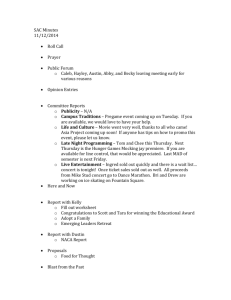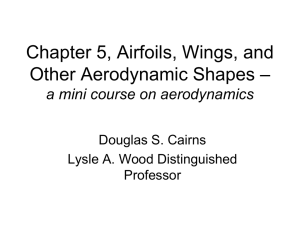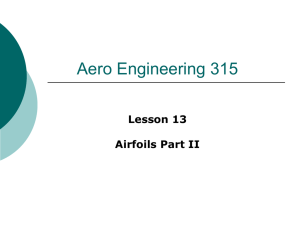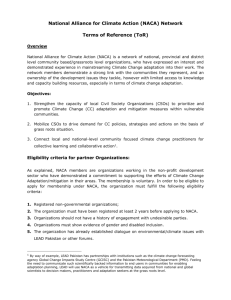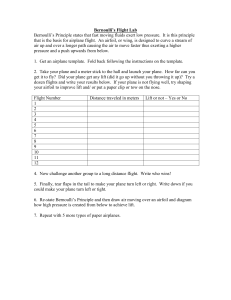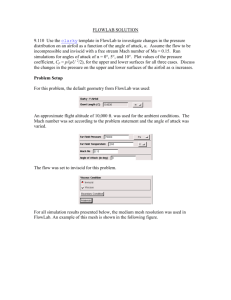Frequency - Conferences
advertisement
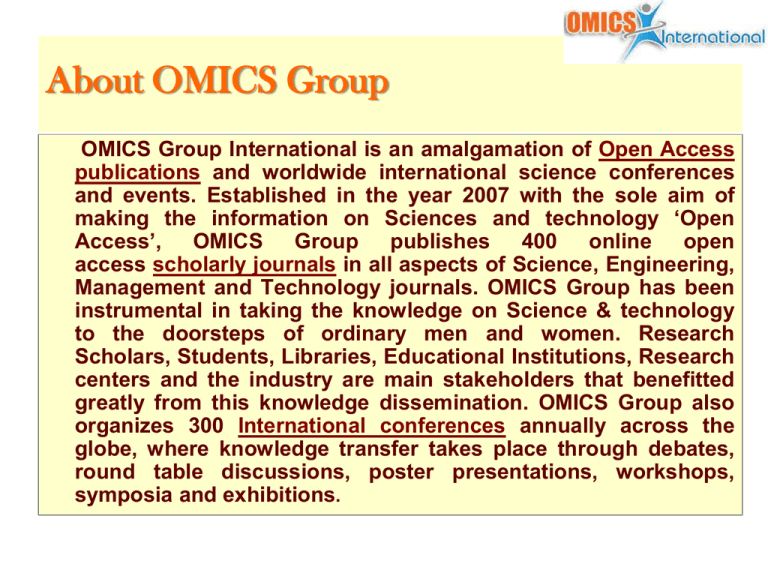
About OMICS Group OMICS Group International is an amalgamation of Open Access publications and worldwide international science conferences and events. Established in the year 2007 with the sole aim of making the information on Sciences and technology ‘Open Access’, OMICS Group publishes 400 online open access scholarly journals in all aspects of Science, Engineering, Management and Technology journals. OMICS Group has been instrumental in taking the knowledge on Science & technology to the doorsteps of ordinary men and women. Research Scholars, Students, Libraries, Educational Institutions, Research centers and the industry are main stakeholders that benefitted greatly from this knowledge dissemination. OMICS Group also organizes 300 International conferences annually across the globe, where knowledge transfer takes place through debates, round table discussions, poster presentations, workshops, symposia and exhibitions. About OMICS Group Conferences OMICS Group International is a pioneer and leading science event organizer, which publishes around 400 open access journals and conducts over 300 Medical, Clinical, Engineering, Life Sciences, Pharma scientific conferences all over the globe annually with the support of more than 1000 scientific associations and 30,000 editorial board members and 3.5 million followers to its credit. OMICS Group has organized 500 conferences, workshops and national symposiums across the major cities including San Francisco, Las Vegas, San Antonio, Omaha, Orlando, Raleigh, Santa Clara, Chicago, Philadelphia, Baltimore, United Kingdom, Valencia, Dubai, Beijing, Hyderabad, Bengaluru and Mumbai. Numerical Study on Active Flow Control using Synthetic Jet Actuators over a NACA 4421 Airfoil AUTHOR Xavier Guerrero Pich Summary Active Flow Control Definition Applications The Zero-Net-Mass-Flux Setting simulations Results Conclusions Active flow control (AFC) Fluid dynamics technology which is used to improve the performance of aerodynamic surfaces under varying conditions. Active: Implies that the technology is applied only when needed, to avoid the drawdown of the natural performance. Zero-Net-Mass-Flux Fluidic oscillator Combustion driven jet actuator Active flow control (AFC) Wide application in different fields of research Aerospace sector Automobile industry Vorticity in the back of the truck when using AFC Tomoscopy flow visualization of the boundary layer without AFC (top) and using AFC (bottom) The Zero-Net-Mass-Flux Aim: Study how a Zero-Net-Mass-Flux (ZNMF) can improve the performance of a NACA 4421 airfoil ZNMF set on a NACA 4421 Fluid field mesh Development Define parameters Evaluate results The Zero-Net-Mass-Flux No mass addition, only momentum to the embedding flow. Blowing stroke and suction stroke through an Cross flow oscillating membrane. ZNMF scheme (Zhang, 2007) Cavity set in the airfoil (Sahni, 2011) The Zero-Net-Mass-Flux Synthetic jet behaviour (quiescent flow) State of the art Experimental studies to appreciate the jet behaviour (Ugrina 2007) Too Outto of enter the boundary Synthetic jet has inside the boundary strong Too layer weak layer No effects on the boundary layer ZNMF jet streamlines (cross flow). (a)Suction stroke; (b) Blowing stroke (Ugrina, 2007) Meshing the NACA 4421 Airfoil Stall process in thick airfoils (Meseguer, 2004) Relative thickness: 𝛿/𝑐 > 0.15 𝛿 𝑐 NACA 4421 Airfoil (Abbott, 1959) = 0.21 Thick airfoil Meshing the NACA 4421 Airfoil Stall process in thick airfoils (Meseguer, 2004) Relative thickness: 𝛿 𝑐 = 0.21 𝛿/𝑐 > 0.15 NACA 4421 Airfoil (Abbott, 1959) Thick airfoil Meshing the NACA 4421 Airfoil First cell height: 𝑦 + ≈ 2.2 Mesh around the airfoil Mesh in the fluid field Setting simulations parameters Dimensionless parameters Mach Number 𝑀∞ = 0.13 Incompressible flow Reynolds Number 𝑅𝑒 = 3 · 106 Turbulent flow Characteristic parameters of the simulations Solver RANS Solver used in the simulations 𝒌 − 𝝎 𝑺𝑺𝑻 Evaluating mesh and parameters 𝐶𝑙 − 𝛼 curve of NACA 4421 airfoil Setting the ZNMF ZNMF can be simulated using boundary conditions Sinusoidal function, without offset (no mass addition) Velocity perpendicular to the surface, with a characteristic frequency Amplitude (A) [𝑚/𝑠] Momentum coefficient 𝑐𝜇 Frequency (f) [𝐻𝑧] Lift coefficient (transient) Sinusoidal function Setting the ZNMF STATIC Simulations 𝐶𝑙 − 𝛼 curve of NACA 4421 airfoil DYNAMIC Simulations Lift coefficient value in dynamic simulations Setting the ZNMF Frequency (f) [𝐻𝑧] Amplitude (A) [𝑚/𝑠] Momentum coefficient 𝑐𝜇 = 𝑀𝑜𝑚𝑒𝑛𝑡𝑢𝑚 𝑛𝑒𝑎𝑟 𝑜𝑟𝑖𝑓𝑖𝑐𝑒 𝑀𝑜𝑚𝑒𝑛𝑡𝑢𝑚 𝑢𝑝𝑠𝑡𝑟𝑒𝑎𝑚 ℎ · 𝐴2 · 𝜌𝑥 𝑐𝜇 = 2 ·𝜌 𝑐 · 𝑈∞ ∞ 𝒇 ≈ 𝟒𝟓 𝑯𝒛 𝑨 ≈ 𝟗𝟎 𝒎/𝒔 Setting the ZNMF Different frequencies have to be studied Same order of magnitude (Durrani, 2011) One order of magnitude larger (Zhang, 2008) SCENARIOS (Frequencies & Angles of attack) Angle of attack Frequency (Hz) 7º 45 250 12º 500 45 250 14º 500 45 250 500 Other parameters settled following experimental bibliography Orifice length (ℎ = 2 𝑚𝑚) Orifice position 𝑥 𝑐 = 0,17 Results: Lift coefficient The ZNMF should decrease the amplitude of the oscillation 7º 12º Frequency 45 Hz 250 Hz 500 Hz Frequency 45 Hz 250 Hz 500 Hz Amplitude 0,046 0,076 0,071 Amplitude 0,078 0,104 0,130 Results: Lift coefficient The ZNMF should decrease the amplitude of the oscillation 7º 12º Frequency 45 Hz 250 Hz 500 Hz Frequency 45 Hz 250 Hz 500 Hz Amplitude 0,046 0,076 0,071 Amplitude 0,078 0,104 0,130 Results: Lift coefficient The ZNMF should decrease the amplitude of the oscillation 14º Frequency 45 Hz 250 Hz 500 Hz Amplitude 0,078 0,104 0,130 Results: Lift coefficient Results: Boundary layer separation Results: Vorticity magnitude Vorticity [1/s] of a NACA 4421 without ZNMF. 𝛼 = 12º (ANSYS Fluent) Vorticity [1/s] of a NACA 4421 using ZNMF. 𝛼 = 12º (ANSYS Fluent) Conclusions The ZNMF improves NACA 4421 performance, best results at 45 Hz Lift coefficient oscillation amplitude supressed Boundary layer separation point moved upstream Separated region diminished The actuator has to be precisely calibrated Future work needed to get study the effect of each parameter Change 𝐶𝜇 value Change orifice parameters (length, position) Compare ZNMF performance with other AFC devices Applying AFC in automobiles Streamlines in the back of the car without AFC (top) or using it (bottom) Numerical Study on Active Flow Control using Synthetic Jet Actuators over a NACA 4421 Airfoil AUTHOR Xavier Guerrero Pich Sustainability study High lift device Fuel savings CO2 emissions decreased ZNMF actuator saves up to 3% of a common commercial aircraft fuel consumption (Agarwal, 2012) Hourly flight A320 consumption 2500 𝑘𝑔𝑘𝑒𝑟𝑜𝑠𝑒𝑛𝑒 /ℎ A320 emissions 3,23 𝑘𝑔𝐶𝑂2 /𝑘𝑔𝑘𝑒𝑟𝑜𝑠𝑒𝑛𝑒 CO2 emissions saved 240 𝑘𝑔 𝐶𝑂2 Setting simulations parameters Dimensionless parameters Mach Number 𝑀∞ = 0,13 Incompressible flow Reynolds Number 𝑅𝑒 = 3 · 106 Turbulent flow RANS Solver LES DNS Setting simulations parameters Dimensionless parameters Mach Number 𝑀∞ = 0,13 Incompressible flow Reynolds Number 𝑅𝑒 = 3 · 106 Turbulent flow 𝑘−𝜖 Solver RANS 𝑘−𝜔 LES 𝑘 − 𝜔 𝑆𝑆𝑇 DNS Setting simulations parameters Dimensionless parameters Mach Number 𝑀∞ = 0,13 Incompressible flow Reynolds Number 𝑅𝑒 = 3 · 106 Turbulent flow 𝑘−𝜖 Solver RANS 𝑘−𝜔 LES 𝒌 − 𝝎 𝑺𝑺𝑻 DNS
